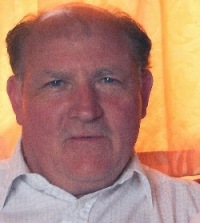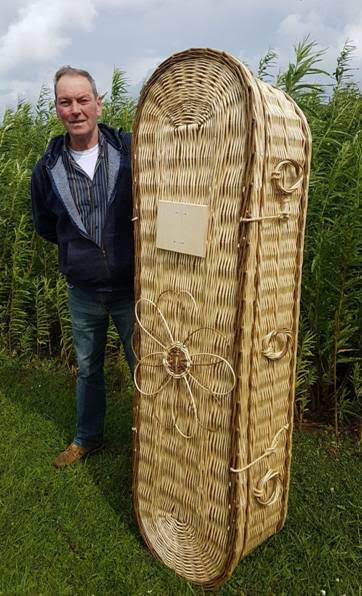 Irish Eyes
Irish Eyes
By
Mattie Lennon
Theatre, Taphophbiaand Green Coffins
I told you in August about the theatre company, dressing Room 1, bringing the musical, "And all his Songs Were Sad" from page to stage. well the Irish premier was staged, to a capacity audience in saint John's Theatre, Listowel, on August 26th.
I had a fairly quiet august myself. Recently I was beside an intellectual at a funeral. You’ll always know an intellectual in a pub, because he won’t have the price of a drink but is not as easy to identify one in a graveyard. (I believe that all funeral undertakers should be obliged to give an undertaking that they would inform mourners of the likelihood of one or more intellectuals being in the cemetery.) As this being of superior intellect gazed into the open grave he asked my opinion on taphophbia. Since I didn’t know the meaning of the word I didn’t have any opinion on it. I wasn’t left in ignorance for long. I soon learned that it is a fear of being placed in a grave while still alive as a result of being incorrectly pronounced dead. I was then promptly informed that the word is from Greek τάφος - taphos, "grave, tomb” and φόβος - phobos, "fear” , which is translated as "fear of graves". He increased my meagre store of knowledge further with the revelation that "Saved by the bell" and "Dead ringer" are both derived from the notion of having a rope attached to a bell outside the coffin that could alert people that the recently buried person is not yet deceased. Of course you, dear reader probably knew that already.
He next turned to how the coffin is so often used in classical allusions etc. He gave me a few examples. The only one I can think of is how Byron (according to my intellectual superior) referred to a gondola as being like, “.. . A coffin clapt in a canoe.” He then informed me that John Philpot Curran once described Robert Peel’s smile as, “Like the silver plate on a coffin.” And how it was quoted by Daniel O Connell in the House of Commons on 26th February 1835. ( He said it was on a Thursday.)
The dear departed was one of my fellow mis-fits who was a bit “different”, a man who marched to a different drummer. And when I described him as a “square peg in a round hole” my new found human enclopedia promised to email me a relevant picture. Which, fair play to him, he did.
I already told you about the opening of Clarkes Funeral Home, In Blessington. It was a specular event attended by clergy of many denominations and several dignitaries. There was much to see, riveting speeches and copious refreshments. But my eyes were glued to a six foot four Donegal man, Martin, of Green Coffins, Shanagh, Fanad, County Donegal, who was making a willow coffin. In this game of skill the only tools he had were what looked like large secateurs and a piece of flat iron. By evening he had completed the body of the coffin. He answered all questions in lay-man’s language and, unusual on this island, he spoke in glowing terms of his boss, Colin McAteer, who took me through a step-by-step explanation of the process.
Colin told me that the willow tree has over 600 varieties. “We use a number of these varieties (different colours and thicknesses) to make our coffins. Our coppice willow stools which can have up to 30 shoots – these are harvested every year. Each rod grows between 3-9 ft each year and when cut grows back the following year without the need to replant. The willow is harvested each spring, graded, seasoned and stored for use later in the year.”
The dried out willow in their bundles (bolts) are soaked to make them less brittle before use. The length of soaking time varies from 1 hour to 8 days depending on variety and thickness of the willow. All their coffins have a timber base – not necessarily for strength but to travel on the rollers of the hearse and crematoriums. The rods are staked and turned up to provide the uprights.
Rods are added around the uprights to form the sides using a variety of techniques including randing and plating. Keeping willow sides this size straight takes experience and patience. When the sides are at the appropriate height you “turn down” the uprights. This must be done before the rods are dried or the rods will be too brittle.
When I commented on Martin’s dexterity at weaving , Colin agreed and said, “ The lid is where all your skills are tested – especially when applying the rounded circular design we use on this coffin. “ He showed me a picture of a Green and White willow coffin with a flower which was a work of art. “ We have been making this design for about the last year and a half but it has never been in our brochures or on our website. It was produced at our work shop in Donegal and dispatched once dried to a funeral director. People want Irish made – they are comparable in price to imported willow coffins.”

|
Martin Boyle with finished coffin |
Colin also has a “Green graveyard”. The Green Graveyard Company was established in 2009 with a view to developing "Natural Burial Grounds" in Ireland. In October 2010 we opened Ireland's first and only Natural Burial Ground, Woodbrook Natural Burial Ground, in Killane Co. Wexford
On the 22nd July 2017 they took the unusual step of holding an information day. This was a "drop by event" where people went look at the grounds and meet the team. In its most simplistic form a natural burial ground is a graveyard where the land has a second use, as a living, developing native Irish woodland and wildflower meadow. Gone are the marble headstones and concrete surrounds that are common place in other Irish burial grounds, replaced instead by a small simple grave marker and the planting of a native Irish tree. More information at; www.facebook.com/greengraveyard/
* * * * *
Fake news ...
An employee of the Jefferson County morgue died this morning, after being accidentally cremated by one of his coworkers.
According to the Beaumont Police Department, 48-year old Henri Paul Johnson decided to take a nap one a stretcher after working for sixteen hours straight.
While he was sleeping, another employee mistook him for the corpse of a 52-year old car accident victim and carried him to the crematory.
Before anyone could notice the mistake, he had already been exposed to temperatures ranging between 1400 to 1800 degrees Fahrenheit and reduced to ashes.
* * * * *
A woman in west Wicklow was on her third husband. One night the latest addition to the marriage bed came in, full of porter, and started laying down the law. For emphasis he was hammering the kitchen table with his fist. Calmly, but sternly, the wife said, "Don't break that table. There was two good men wake'd on that an' it'll be wanted agin."
Click on author's byline for bio and list of other works published by Pencil Stubs Online.
|